Related Research Articles

Louis VIII, nicknamed The Lion, was King of France from 1223 to 1226. From 1216 to 1217, he also claimed the Kingdom of England. Louis was the only surviving son of King Philip II of France by his first wife, Isabelle of Hainaut, from whom he inherited the County of Artois.
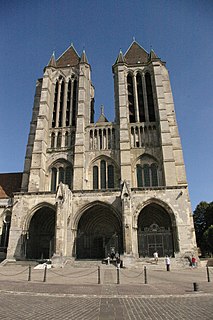
Noyon is a commune in the Oise department in northern France. It lies on the Oise Canal about 100 kilometers (60 mi) north of Paris.

Simon de Montfort, 5th Earl of Leicester, known as Simon IVde Montfort and as Simon de Montfort the Elder, was a French nobleman and famed knight of the early 13th century. He is widely regarded as one of the great military commanders of the Middle Ages. He took part in the Fourth Crusade and was one of the prominent figures of the Albigensian Crusade. Montfort is mostly noted for his campaigns in the latter, notably for his triumph at Muret. He died at the Siege of Toulouse in 1218. He was lord of Montfort-l'Amaury from 1188 to his death and Earl of Leicester in England from 1204. He was also Viscount of Albi, Béziers and Carcassonne from 1213, as well as Count of Toulouse from 1215.

Eudes III, commonly known in English as Odo III, was duke of Burgundy between 1192 and 1218. Odo was the eldest son of duke Hugh III and his first wife Alice, daughter of Matthias I, Duke of Lorraine.

The Tournai Cathedral, or Cathedral of Our Lady , is a Roman Catholic church, see of the Diocese of Tournai in Tournai, Belgium. It has been classified both as a Wallonia's major heritage since 1936 and as a World Heritage Site since 2000.
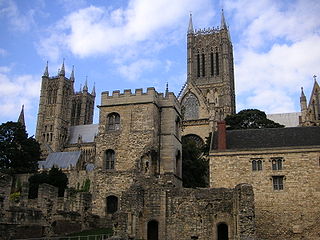
Hugh of Wells was a medieval Bishop of Lincoln. He began his career in the diocese of Bath, where he served two successive bishops, before joining royal service under King John of England. He served in the royal administration until 1209, when he was elected to the see, or bishopric, of Lincoln. When John was excommunicated by Pope Innocent III in November 1209, Hugh went into exile in France, where he remained until 1213.

The Roman Catholic Diocese of Tournai is a diocese of the Latin Rite of the Roman Catholic church in Belgium. The diocese was formed in 1146, upon the dissolution of the diocese of Noyon & Tournai, which had existed since the 7th century. It is now suffragan of the archdiocese of Mechelen-Brussels. The cathedral is Notre-Dame de Tournai which has been classified both as a Wallonia's major heritage since 1936 and as a World Heritage Site since 2000.
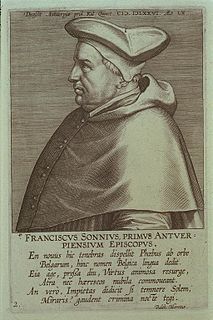
Franciscus Sonnius was a theologian during the time of the Catholic Reformation, the first bishop of 's-Hertogenbosch and later the first bishop of Antwerp. His family name was Van de Velde, but in later years he called himself after his native place, Son in Brabant. He came from the same noble family as philosopher Heymeric de Campo. The family has three golden mill-irons in their coat-of-arms, a sign that is depicted on the chair of the first bishop in the cathedral of Antwerp.

The Roman Catholic Diocese of Bruges, is a suffragan diocese in ecclesiastical province of the primatial Metropolitan archdiocese of Mechelen-Brussels.

The Prior of Christ Church was the prior of Christ Church Cathedral Priory in Canterbury, attached to Canterbury Cathedral.

Saint Eleutherius of Tournai is venerated as a saint and considered the first bishop of Tournai. The Catholic Encyclopedia writes that "historically there is very little known about St. Eleutherius, but he was without doubt the first Bishop of Tournai."

Berenguer de Palou II was bishop of Barcelona from 1212 to 1241. He was a major supporter of James I of Aragon.

The great gilt-copper and enamel Reliquary Shrine of Saint Eleutherius in the cathedral of Tournai (Belgium), one of the masterpieces of Gothic metalwork, was commissioned by Bishop Walter de Marvis of Tournai, and completed in 1247, on the occasion of the retranslation of relics of Saint Eleutherius of Tournai, traditionally the city's first bishop. The shrine takes the architectural form of a chasse or gabled casket; its more distant prototype is the gabled sarcophagus that was an established Romanesque convention in Northern Europe, "a form which was quite fitting," Marvin Ross observed in discussing the similarly shaped gilt-copper and enamel reliquary of Saint Amand in the Walters Museum "since these châsses were in a sense also tombs". As with the prototypical tombs, a blind arcade runs along the base, forming niches with the protective seated figures of Apostles and Prophets. In its gable end St Eleutherius appears, holding his crozier in one hand and in the other a model of the cathedral with its five spires.

John was a prelate in the Kingdom of Hungary in the 12th and 13th centuries. He was Bishop of Csanád between 1198 and 1201, Archbishop of Kalocsa from 1202 to 1205 and Archbishop of Esztergom between 1205 and 1223. He crowned Ladislaus III of Hungary, Andrew II of Hungary and Coloman of Halych king. Andrew II appointed him to govern the kingdom during his crusade between 1217 and 1218.
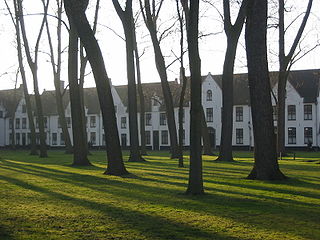
The Princely Beguinage Ten Wijngaerde is the only preserved beguinage in the Belgian city of Bruges. There are no more Beguines living there, but since 1927 it functions as a convent for Benedictines, founded by canon Hoornaert. In the same year the houses at the west side were also reshaped and enlarged into the Monasterium De Wijngaard, a priory of Benedictine nuns.

Clemens Crabeels (c.1534–1592) was the third bishop of 's-Hertogenbosch, in the Habsburg Netherlands, from 1584 until his death in 1592.
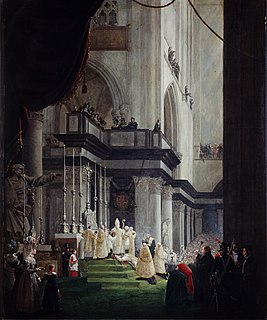
Jean-François or Jan Frans van de Velde (1779–1838) was the 20th bishop of Ghent, in Belgium, from November 1829 until his death.
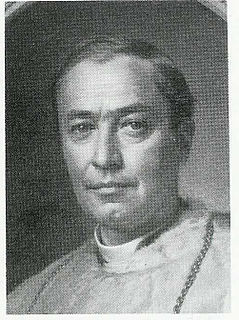
Gustave Joseph Waffelaert (1847–1931) was the 22nd bishop of Bruges in Belgium.
References
- 1 2 3 Paul Declerck (1922-1981). "Bisschop Walter van Marvis en deeerste Minderbroeder kloosters in het Bisdom Doornik" . Retrieved 8 May 2019.
- 1 2 3 4 5 Frits Schetsken (compiler). "Walter de Marvis (1175-1252)" . Retrieved 8 May 2019.
- ↑ Jeroen Westerman (8 December 2016). "Overzichten van kerkelijke hoogwaardigheidsbekleders .... Bisschoppen van Doornik" (PDF). De Onze-Lieve-Vrouwekathedraal van Doornik : onafhankelijkheidsmonument voor een bisdom. Leiden University Repository. pp. 696–697. Retrieved 8 May 2019.
- ↑ Louis Ellies Du Pin (1713). A Compedious History of the Church, from the beginning of the world to this present time. Bernard Lintott. p. 212.
- ↑ "Bruges Béguinage". SpottingHistory.com. Retrieved 9 May 2019.